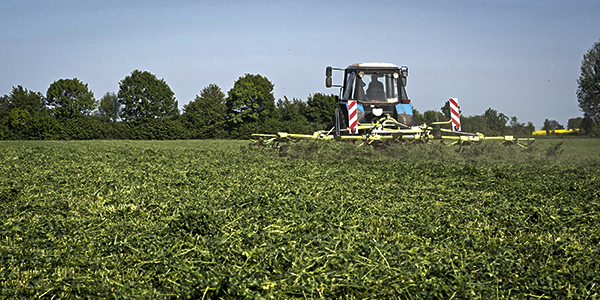AGRONOMICSUPPORT
YOU CAN TAKETO THE FIELD
Preparing Alfalfa for the Winter Ahead
Management of alfalfa in the fall is a balancing act between avoiding winter damage and capturing additional tonnage in the current year. Many factors feed into the decisions on how to handle the crop for this year and the longevity of it. Some factors can be controlled, and some factors are out of our control. I want to discuss these factors to help with best practices for your operation.
Variety selection plays a large role in survival rate of the crop. Selecting a variety with good winter hardiness and moderate to excellent disease rating will tolerate late fall cuttings. Soil fertility is vitally important for maintaining and highly productive alfalfa stands. Potassium is important for developing plants with good winter survival. Usually younger stands survive winter better than older stands because of disease and less physical damage. 6” stem and leaf stubble should be left standing to allow the snow to catch and help protect the crowns from cold weather. If stands are harvested in a 35-day cut schedule or less, a minimum of 5-6 weeks of growth should be allowed before the first killing frost. This allows plants to enter winter with a higher root carbohydrate levels and insures a quicker green up in the spring. This means avoid cutting usually between September 1st and October 15th in Wisconsin. If you need the forage cut after this time frame.
There are some uncontrollable factors that can play a role in the survival rate of your alfalfa crop over winter. Excessive soil moisture in the fall can affect the hardiness of the alfalfa. Also ponding of water that freezes can create sheet of ice that smother out plants. Warm weather in mid-winter can cause alfalfa to break dormancy and have less resistance to freezing. Snow cover of 6” or more can protect stands, so if soil temperatures drop below 15 degrees with no snow, plants can be injured or possible die. Alfalfa plants require long periods of cool temperatures to prepare for cold winters. Sudden changes in temps from warm to cold can also reduce the hardening of the plant.
Understanding what is needed for alfalfa in the fall combined with uncontrollable factors will help make decisions to avoid the risk of winter injury. Make sure to manage alfalfa stands in fall to ensure longevity of the stand. WeatherTrends 360® is a tool inside the digital platform of Advantage Acre® that can be used to assist in the decision process. This platform will create an 11-month forecast and show trends over the years for background knowledge of your farm. Planning is key for the success of your crop!
References and additional information:
https://extension.psu.edu/winter-alfalfa-survival
https://hayandforage.com/article-607-what-does-fall-dormancy-of-alfalfa-really-mean-.html
https://crops.extension.iastate.edu/cropnews/2019/03/alfalfa-winter-survival-complicated-subject






Technical Team Agronomist